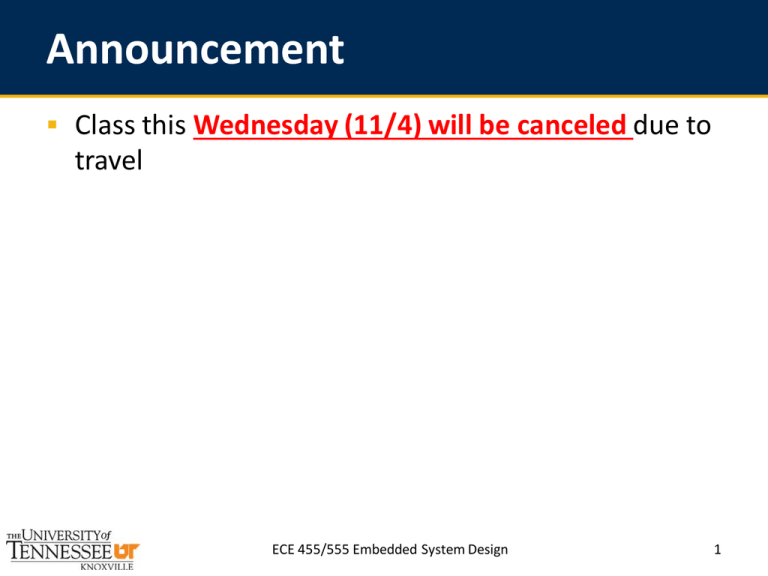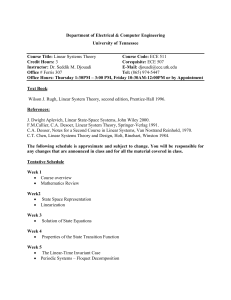Announcement Class this due to travel
advertisement

Announcement
Class this Wednesday (11/4) will be canceled due to
travel
ECE 455/555 Embedded System Design
1
Recap from last two classes
Hardware support
CMOS, Clock gating, Supply shutdown, Dynamic voltage
scaling
Dynamic power management
Adjusts power mode to adapt to workload variations
Baseline: greedy policy
• Break-even time TBE
Energy saving
Predictive techniques
Power manager
Advanced Configuration and Power Interface (ACPI)
Holistic approach
ECE 455/555 Embedded System Design
2
ECE 455/555
Embedded System Design
Operating Systems - I
Wei Gao
Fall 2015
Basic Functions
OS controls resources:
who gets the CPU;
when I/O takes place;
how much memory is allocated.
Application programs run on top of OS services
Challenge: manage multiple, concurrent tasks.
ECE 455/555 Embedded System Design
4
Example: Sensor Motes
Sensing
Sampling (multiple) sensors in different rates
Communication
Send data
Receive data
Computation
Data processing and aggregation
Routing
ECE 455/555 Embedded System Design
5
Life without Processes
Code turns into a mess:
Spaghetti code
do all tasks in a single piece of
code (with a loop)
no separation of concern
Control structure gets very
complex
Hard to guarantee different
timing requirements
Cannot handle varying execution
time or rate
Cannot handle dynamic task
arrivals
time
A
B
C
A
C
ECE 455/555 Embedded System Design
A_code();
…
B_code();
…
if (C) C_code();
…
A_code();
…
switch (x) {
case C: C();
case D: D();
...
6
Co-Routines Methodology
Idea to realize controlled concurrency
Separate tasks into different code segments (co-routines)
Co-routines voluntarily give up control to other co-routines.
Pattern of control transfers and context-switch are embedded in the
code.
Co-routine 1
ADR r14,co2a
co1a …
ADR r13,co1b
MOV r15,r14
co1b …
ADR r13,co1c
MOV r15,r14
co1c ...
Co-routine 2
co2a …
ADR r14,co2b
MOV r15,r13
co2b …
ADR r14,co2c
MOV r15,r13
co2c …
ECE 455/555 Embedded System Design
7
Process
A process is a unique execution of a program.
Several copies of a program may run simultaneously or at
different times.
A process has its own context:
Data in registers, PC, status, memory.
Stored in activation record
OS manages processes.
TinyOS: a task is similar to a process
ECE 455/555 Embedded System Design
8
Processes and CPUs
Activation record
process context.
Context switch:
current CPU context goes
out
new CPU context goes in
process 1
context
process 2
context
...
PC
registers
CPU
memory
ECE 455/555 Embedded System Design
9
Cooperative Multitasking
Improvement to co-routines:
hides context switching mechanism;
still relies on processes to voluntarily give up CPU.
Each process allows a context switch at cswitch() call.
Separate scheduler chooses which process runs next.
if (x > 2)
sub1(y);
else
sub2(y, 2);
cswitch();
proca(a, b, c);
Process 1
Student A
save_state(current);
p = choose_process();
load_and_go(p);
Scheduler
TA
ECE 455/555 Embedded System Design
proc_data(r, s, t);
cswitch();
If (val1 == 3)
abc(val2);
rst(val3);
Process 2
Student B
10
Problems with Cooperative Multitasking
Programming errors can keep other processes out:
process never gives up CPU;
process waits too long to switch, missing input.
Process2() {
x = global1; /* global1 is an input to the process */
while (x < 500)
x = aproc(global2); /* subroutine does its work */
cswitch();
}
ECE 455/555 Embedded System Design
11
Preemptive Multitasking
No more voluntary release of CPU
Operating System (OS) is now in charge
Timer
Most powerful form of multitasking:
interrupt
OS controls when context switches;
OS determines what process runs next.
Use periodic timer interrupts to call OS to
switch contexts
interrupt
P1
OS
CPU
interrupt
P1
OS
P2
Flow of control with preemption
ECE 455/555 Embedded System Design
time
12
Process Scheduling
Who gets CPU?
Usually priority-based
• Priority can be based on deadline, requested time, or…
When context switch occurs?
Low priority tasks are running while high priority tasks are
waiting
We have two classes to introduce different
scheduling algorithms
Key issue of real-time operating systems
ECE 455/555 Embedded System Design
13
TinyOS: Tasks vs. Interrupts
Tasks do intensive computations
Unpreemptable FIFO scheduling
Bounded number of pending tasks
Events handle interrupts
Interrupts trigger lowest level events
Events can signal events, call commands, or post tasks
Two priorities
Interrupt
POST
events
Tasks
Tasks
Preempt
FIFO
commands
commands
Interrupts
Hardware
ECE 455/555 Embedded System Design
Time
14
POSIX
IEEE standards designed to provide application
portability between Unix variants.
IEEE 1003.1 defines a Unix-like OS interface.
IEEE 1003.2 defines the shell and utilities
IEEE 1003.4 defines real-time extensions.
Supported by many operating systems
Variants of UNIX: AIX, HP-UX, Solaris, Linux
Many commercial RTOS, e.g., VxWorks
Windows provides similar services
ECE 455/555 Embedded System Design
15
Processes in POSIX
Create a process with fork:
parent process keeps executing the old program;
child process executes a new program.
Process A
Process A
Process B
ECE 455/555 Embedded System Design
16
Create a New Process using fork()
A process can create a child process by making a
copy of itself
Parent process is returned with the child process ID
Child process gets a return value of 0
child_id = fork();
if (child_id == 0) {
/* child operations */
} else {
/* parent operations */
}
ECE 455/555 Embedded System Design
17
Overlay a Process using execv()
Child process usually runs different code
Use execv() to overlay the code of a process
Parent uses wait() to wait for child process to finish and then
release its memory
childid = fork();
if (childid == 0) {
execv(“mychild”,childargs);
exit(0);
} else {
parent_stuff();
wait(&csstatus);
exit(0);
}
ECE 455/555 Embedded System Design
18
Process States
A process can be in one of three states:
executing on the CPU;
ready to run;
waiting for data.
executing
gets
CPU
Scheduler
preempted
needs
data
gets data
and CPU
gets data
ready
waiting
needs data
ECE 455/555 Embedded System Design
19
Process Scheduling: Embedded vs.
General-Purpose
Workstations try to avoid starving processes of CPU
access.
Fairness = access to CPU.
Embedded systems must meet deadlines.
Low-priority processes may not run for a long time.
ECE 455/555 Embedded System Design
20
Priority-Driven Scheduling
Every process has a priority.
CPU goes to the highest-priority ready process
Variants
Fixed vs. dynamic priority
Preemptive vs. non-preemptive
ECE 455/555 Embedded System Design
21
Scheduling Example
Each process has a fixed priority (1 highest);
P1: priority 1; P2: priority 2; P3: priority 3.
P3 released
P1 released
P2 released
P2
0
P1
10
20
P2
30
P3
40
ECE 455/555 Embedded System Design
50
time
60
22
The Scheduling Problem
Can we meet all deadlines?
Must be able to meet deadlines in all cases.
How much CPU horsepower do we need to meet our
deadlines?
Timing violations: What happens if a process doesn’t finish by
its deadline?
Hard deadline: system fails if missed.
Soft deadline: user may notice, but system doesn’t necessarily fail.
ECE 455/555 Embedded System Design
23
Example: Space Shuttle Software
Error
Space Shuttle’s first launch was delayed by a
software timing error:
Primary control system PASS and backup system BFS.
BFS failed to synchronize with PASS.
A change to one routine added unnoticed delay that threw
off start time calculation.
1 in 67 chance of timing problem.
ECE 455/555 Embedded System Design
24
Summary
OS: manage multiple, concurrent tasks
Process
Co-routines methodology
Multitasking with context switch
Processes in TinyOS and POSIX
fork(), execv()
Process states and management
Process scheduling
Priority-driven scheduling
Space shuttle software error
Inter-process communication
Shared memory
Message passing
ECE 455/555 Embedded System Design
25
Reading
Textbook: 6.1-6.3
Recommended reading:
Operating System Concepts, A. Silberschatz, B. Galvin
and G. Gagne, 8th edition, 2008.
(the famous “dinosaur” book)
ECE 455/555 Embedded System Design
26



